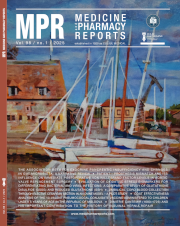Real world outcomes with Ibrutinib monotherapy in chronic lymphocytic leukemia: a single center experience
DOI:
https://doi.org/10.15386/mpr-2800Keywords:
Chronic Lymphocytic Leukemia, CLL, IbrutinibAbstract
Introduction. The advent of Bruton’s tyrosine kinase (BTK) inhibitors brought about a paradigm shift in the management of chronic lymphocytic leukemia (CLL), by offering a well-tolerated chemotherapy-free approach. Here, we share the experience with ibrutinib of a major Romanian regional cancer center.
Methods. We screened patients treated for CLL in our center over 6 years (2017- 2022) and included those who were treated with ibrutinib either in the first line of therapy or in subsequent lines.
Results. We enrolled 61 patients, 40 with treatment-naïve (TN) CLL and 21 with relapsed/refractory (R/R) CLL, with a median age at treatment initiation of 65 years. Concerning the prognostic-predictive workup, IgHV mutational status was available for 78.7% of the patients, TP53 sequencing for 82%, assessment of 17p deletion for 82%, and CD38 marker analysis was performed for 70.5%. With a median follow-up period of 55 months, the overall response rate (ORR) was 90.2%, with a median progression-free survival (PFS) of 33 months and a median overall survival (OS) that has not been reached. In our cohort, albeit non-significant statistically, patients with TP53 mutation had a shorter OS and those with mutated IgHV, a shorter PFS. Rai 3-4 and Binet C stages at diagnosis were associated with a shorter PFS, but not OS. In our cohort, the correlation between survival and high Cumulative Illness Rating Scale (CIRS) index was not statistically significant. Ibrutinib was generally well tolerated in our cohort, as only 14.8% of our patients discontinued treatment due to adverse effects.
Conclusion. Our study suggests that ibrutinib is a valid therapeutic option for TN or R/R CLL patients, with a high ORR and a good safety profile.
Downloads
Published
How to Cite
Issue
Section
License
The authors are required to transfer the copyright of the published paper to the journal. This is done by agreeing to sign the Copyright Assignment Form. Whenever the case, authors are also required to send permissions to reproduce material (such as illustrations) from the copyright holder.

The papers published in the journal are licensed under a Creative Commons Attribution-NonCommercial-NoDerivatives 4.0 International License.

